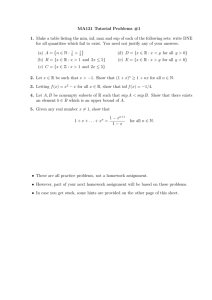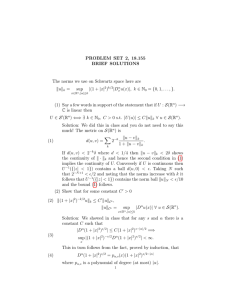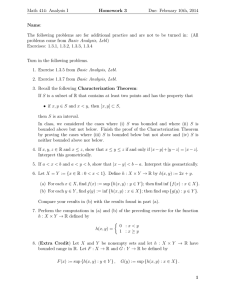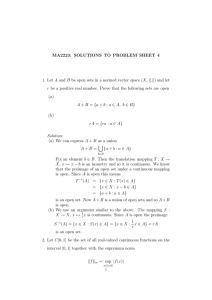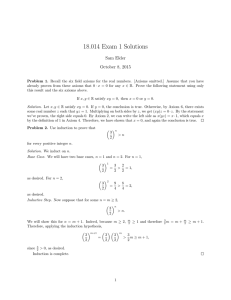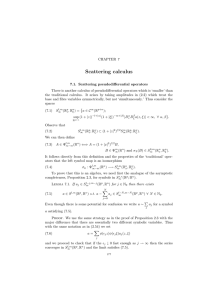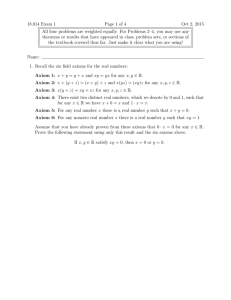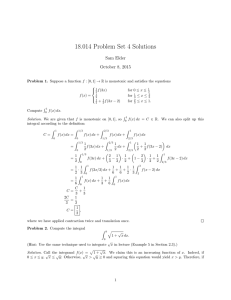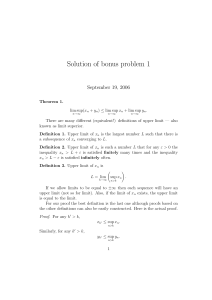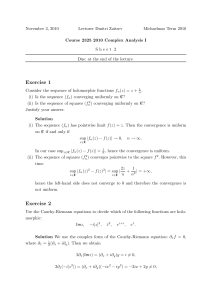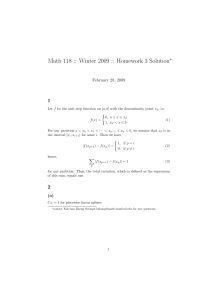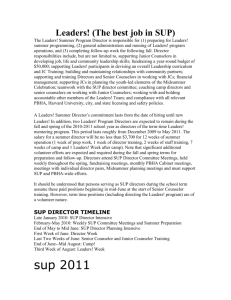The L´ evy-Khinchine Formula
advertisement
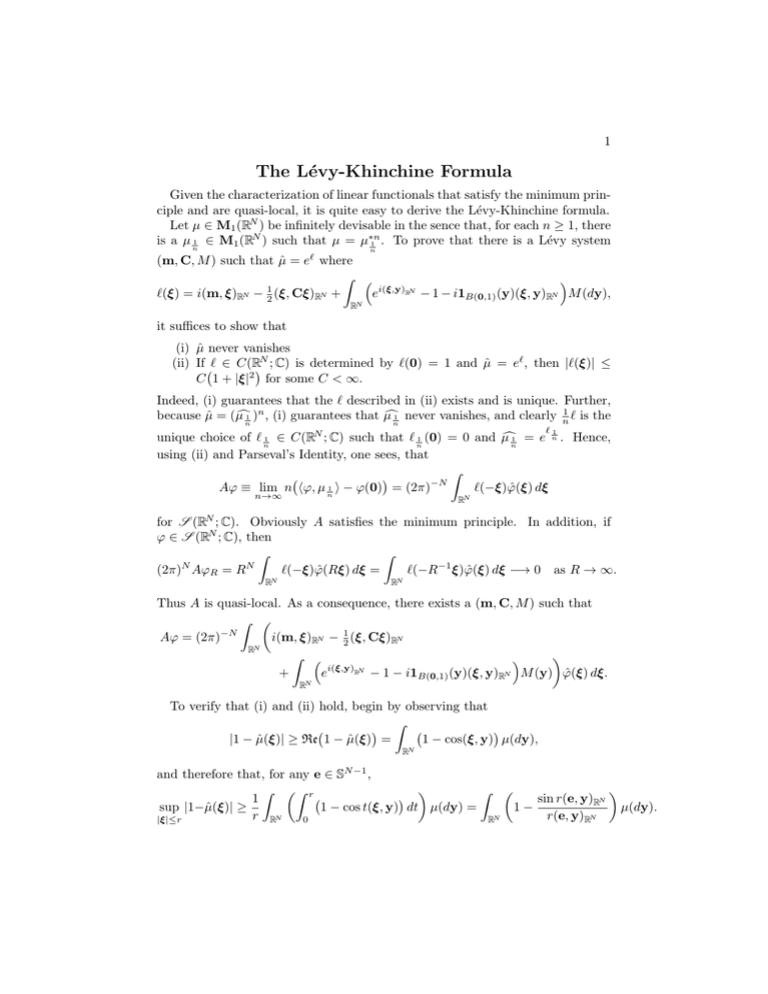
1
The Lévy-Khinchine Formula
Given the characterization of linear functionals that satisfy the minimum principle and are quasi-local, it is quite easy to derive the Lévy-Khinchine formula.
Let µ ∈ M1 (RN ) be infinitely devisable in the sence that, for each n ≥ 1, there
is a µ n1 ∈ M1 (RN ) such that µ = µ∗n
1 . To prove that there is a Lévy system
n
(m, C, M ) such that µ̂ = e` where
Z `(ξ) = i(m, ξ)RN − 12 (ξ, Cξ)RN +
ei(ξ,y)RN − 1 − i1B(0,1) (y)(ξ, y)RN M (dy),
RN
it suffices to show that
(i) µ̂ never vanishes
(ii) If ` ∈ C(RN ; C) is determined by `(0) = 1 and µ̂ = e` , then |`(ξ)| ≤
C 1 + |ξ|2 for some C < ∞.
Indeed, (i) guarantees that the ` described in (ii) exists and is unique. Further,
because µ̂ = (µcn1 )n , (i) guarantees that µcn1 never vanishes, and clearly n1 ` is the
`1
unique choice of ` n1 ∈ C(RN ; C) such that ` n1 (0) = 0 and µcn1 = e n . Hence,
using (ii) and Parseval’s Identity, one sees, that
Z
−N
Aϕ ≡ lim n hϕ, µ n1 i − ϕ(0) = (2π)
`(−ξ)ϕ̂(ξ) dξ
n→∞
RN
for S (RN ; C). Obviously A satisfies the minimum principle. In addition, if
ϕ ∈ S (RN ; C), then
Z
Z
N
N
(2π) AϕR = R
`(−ξ)ϕ̂(Rξ) dξ =
`(−R−1 ξ)ϕ̂(ξ) dξ −→ 0 as R → ∞.
RN
RN
Thus A is quasi-local. As a consequence, there exists a (m, C, M ) such that
Z −N
Aϕ = (2π)
i(m, ξ)RN − 12 (ξ, Cξ)RN
N
R
Z i(ξ,y)RN
N
+
− 1 − i1B(0,1) (y)(ξ, y)R M (y) ϕ̂(ξ) dξ.
e
RN
To verify that (i) and (ii) hold, begin by observing that
Z
|1 − µ̂(ξ)| ≥ Re 1 − µ̂(ξ) =
1 − cos(ξ, y) µ(dy),
RN
and therefore that, for any e ∈ SN −1 ,
Z Z r
Z 1
sin r(e, y)RN
1 − cos t(ξ, y) dt µ(dy) =
1−
µ(dy).
sup |1−µ̂(ξ)| ≥
r RN
r(e, y)RN
|ξ|≤r
0
RN
2
Hence, if s(T ) ≡ inf |t|≥T 1 −
R > 0,
sin r(e,y)RN
r(e,y)RN
for T > 0, then, s > 0 and, for any
sup |1 − µ̂(ξ)| ≥ s(rR)µ {y : |(e, y)RN | ≥ R} .
(*)
|ξ|≤r
Now choose r > 0 so that sup|ξ|≤r |1 − µ̂(ξ)| ≤ 12 . Then, since |1 − z| ≤
| log z| ≤ 2|1 − z|, |`(ξ)| ≤ 1, and so
1
2
=⇒
`(ξ) 1
|1 − µcn1 (ξ)| = 1 − e n ≤
n
for |ξ| ≤ r. Applying (*) with µ replaced by µ n1 and using this estimate, we
have that, for any R > 0,
1
≥ s(rR)µ n1 {y : |(e, y)RN | ≥ R} ,
n
which, because
|1 − µcn1 (ρe)| ≤ ρR + 2µ n1 {y : |(e, y)RN | ≥ R} ,
means that
sup |1 − µcn1 (ξ)| ≤ ρR +
|ξ|≤ρ
In particularly, by taking R =
1
4ρ ,
2
ns(rR)
for all (ρ, R) ∈ (0, ∞).
we get
sup |1 − µcn1 (ξ)| ≤
|ξ|≤ρ
1
2
+
r ,
4 ns 4ρ
and so, for all ρ > 0,
(**)
sup |1 − µcn1 (ξ)| ≤
|ξ|≤ρ
1
2
if n ≥
8
s
r
4ρ
.
From (**), it is clear that, for each ρ > 0, there is an n such that |µcn1 (ξ)| ≥ 12 and
therefore |µ̂(ξ)| ≥ 2−n for |ξ| ≤ ρ, and this completes the proof of (i). Finally,
from (**), |`(ξ)| ≤ n if |ξ| ≤ ρ and n ≥ 8r . Since there is an such that
s
4ρ
s(T ) ≥ T 2 for T ∈ (0, 1], it follows that
|`(ξ)| ≤ 1 +
128|ξ|2
.
r2






